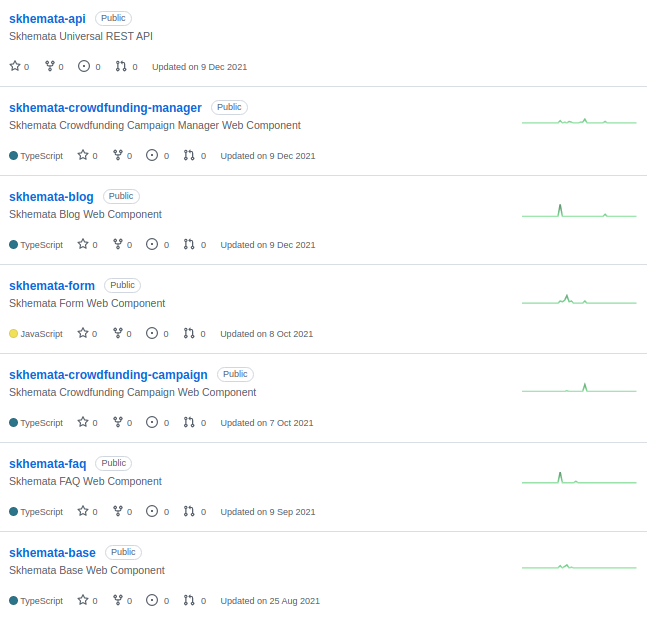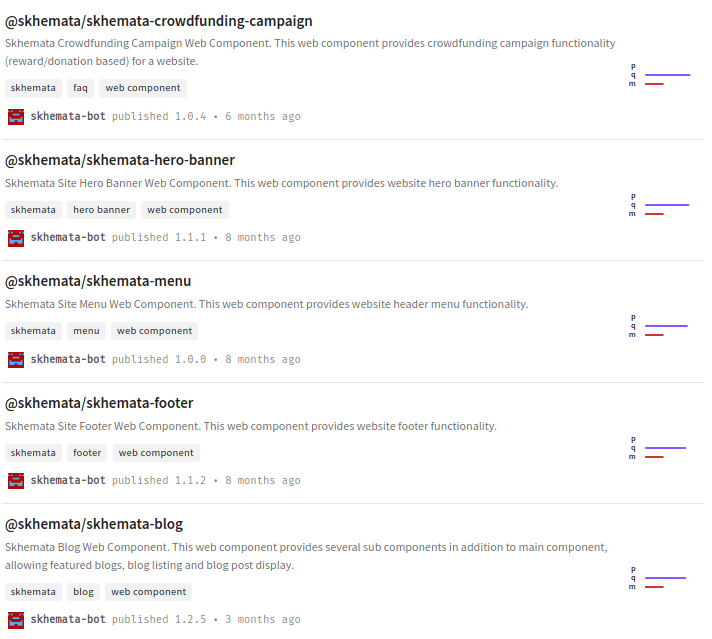
Skhemata web components are now publicly available on Github and NPM. This means you can now access the source code for the Skhemata components from any of these two services. Before this recent update, all repositories and packages were only available privately for clients who subscribed. However note that to use skhemata web components you may still require subscription account. Many of web components Skhemata provides also make use of our Universal REST API. Make sure to check licensing for each web component before using it.


How does it work?
If you want to build or use our web components, you will need to import the code into your project. There are two different kinds of web components that you can import, first is a static component, these components don’t require any use of an API in order to run on your platform or website. An example of this could be a testimonial component where you manually or statically configure the images and descriptions for the testimonials that you want to add to your website. The second is the type of component that requires access to the universal API. This is where you will need to store and grab data. An example of this type of component could be the donation component, where users can donate to a crowdfunding campaign on your website or platform. This component will need to save data into an API. Such components will be utilizing an API to store the backer’s email address, first name, last name, etc, for when the campaign creator wants to access that information again.
Although there are different types of components, you will have access to the front-end source code for all of them. You won’t, however, be able to use any components that require an API without being on a subscription plan, and here’s why.
Every client who is subscribed will be provided with an API instance, which means if you want to do any data computation, you will need access to your specific back-end instance and reference it within the code. Without the correct reference, you won’t be able to use such components or store relevant data. This is why we have opened up the front end source code for the components to the public. You will not only have easier access, but you can try out the components that may not require any API access, free of charge. This isn’t the only thing that we’ve done either. We have other plans in the pipeline.
Widget Capabilities
Since releasing the source code, we have been working on a new feature for the web components. This is the widget capability. Allowing you to copy/paste a small snippet of widget code onto any new or existing website in order to host that single component. This widget will serve the component from a CDN (content delivery network). Without this feature, you would have to import the component and reference the API instance manually. The widget feature cuts down on development time compared to importing the component as you normally would, although you will be more limited in terms of customization.
With this widget feature, you will also be able to manipulate it via HTML attributes. This will allow for easier access to adding the component to your website and will also make it easier to manipulate the component as well. So instead of importing the entire project with the base component features and other code, you will only need to copy/paste a small snippet of HTML.
With most services out there, you are limited to only adding HTML code to your site. Take Wix for example, you will only be able to add HTML to your site without having a high level of access to the source code of the project. This can be said for many different CMS and other services such as Squarespace, Shopify, and more. This is where the widget comes in handy. All dependencies for components are already bundled into the widget which is served from the Skhemata CDN. It’s a low code approach to building modern web components that can be accessed from anywhere into any project.
We want to make our components as accessible as possible, and the widget is allowing us to do that. So if you are a web developer with clients that are using different services, you will still be able to provide them with the same features that you normally would if you were building a custom project.
As you can see there are some exciting new changes coming to from Skhemata. For more exciting info and discussion or if you have any questions, please join our Discord Community Chat.